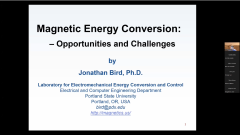Structural Magnetostrictive Alloys: From Flexible Sensors to Energy Harvesters and Magnetically Controlled Auxetics
Novel sensors and energy harvesting transducers take advantage of the significantly expanded design space made possible by recent advances in structural magnetostrictive alloys. These alloys can be machined and welded, have high fracture toughness, and can actuate, sense, and carry load while subjected to tension, compression, and bending. The talk includes an introduction to magnetostrictive materials and transduction, and a discussion on the use of low-cost rolling and annealing methods in lieu of more costly crystal growth methods for making bulk iron-gallium (Galfenol) and iron-aluminum (Alfenol) alloys. The process of using magnetostrictive materials to convert mechanical energy into magnetic energy and then into electrical energy is explained and demonstrated using sensors and energy harvesting devices as examples. Examples of magnetostrictive devices include prototypes ranging in size from nanowire-based pressure sensors to huge structures floating in the ocean that convert wave energy into electrical power for "community-scale" energy needs. The recent discovery of a particularly unique attribute of these alloys, their auxetic behavior, will also be discussed. In both Galfenol and Alfenol, both strain and magnetic fields can produce simultaneous increases in lateral and longitudinal dimensions, with measured values of the resulting Poisson ratio being not only negative, but as low as -2.0 in some cases. Mechanical, aerospace and civil engineers should find the discussion on the use of magnetic fields to control auxetic behavior quite interesting.
Structural Magnetostrictive Alloys: From Flexible Sensors to Energy Harvesters and Magnetically Controlled Auxetics
 Cart
Cart Create Account
Create Account Sign In
Sign In





